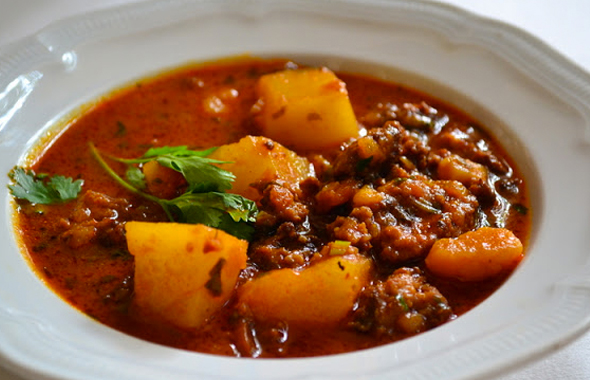Mama’s Punjabi Recipes Aloo Wadiyan (POTATO & SUN DRIED LENTIL DUMPLING CURRY)
Wadiyan are by far the most Punjabi of all foods and in fact, the Punjab border town of Amritsar is famous for its aromatic and spicy version, along with Amritsari papad. There is a bazaar behind the Golden Temple complex which is known for its foodstuff and a whole lane is devoted to these two delicacies.
There are several types of wadiyan but I think that the ones that are made of skinless urad daal (lentils) are the most flavorful. In the way that my mother used to make them, the daal is first ground finely, then made into a paste into which other spices and peppers are mixed in. The paste is then formed into round nuggets, about 1 to 2 inches in diameter and left to dry on a coarse muslin or cotton sheet in the hot Punjab sun. Within two days, the outer shell is dry, then after another two days the nuggets are stripped off the cloth and turned over to dry some more. In a week the wadiyan are fully dried and ready for cooking.
But using wadiyan requires care. Do not keep wadiyan in the pantry because insects can infest them. There is a better way to store them safely. Simply store them in a plastic zip bag in the fridge, just as you should also store papad. Always roast and brown the wadiyan in a toaster oven, then you can keep them in the pantry for a long time without fear of insects and they are ready for cooking. Keep the roasted wadiyan in a ziplock bag to keep the humidity out. Some people roast the wadiyan in a little oil and then store them in the pantry; but I have found they may get an acrid smell after some time.
Wadiyan can be used with many types of vegetables, beans or even with rice as an ingredient which adds a burst of flavor and a slightly pungent smell. It is not a condiment, but is rather like adding paneer to different dishes, but the secret to cooking with wadiyan is to roast and brown them first as this prevents them from crumbling and falling apart and giving a raw daal taste.
There are also wadiyan made of moong daal which are smaller in size and is popular in Gujarat. Over the past fifteen years, wadiyan made of soya powder have become popular too because of their reasonable price, spongy texture that absorbs the curry and their healthy benefits. But the true, Punjabi tasting ones, in my opinion, are the ones made of urad daal.
Ingredients:
• 4 medium size aloo (potatoes)
• 2 medium size Amritsari wadiyan (sun dried lentil dumpling)
• 2 medium pyaaz (onion) – peeled and finely chopped
• 2 medium tamater (tomato) – soft ones are best, chopped
• 5 cloves of lasan (garlic) – peeled and finely chopped
• 1 tablespoon adrak (ginger) – peeled and finely chopped
• 6 tablespoons of vegetable or olive oil
• 2 cups of water
• Spices (to taste): namak (salt), mirch (red pepper), haldi (tur meric), dhania (coriander), garam masala
Directions:
1. Peel the potatoes and cut them into medium sized quarters. Leave them in a bowl of water so that they do not turn a dark color.
2. In a medium saucepan prepare the masala in a medium frying pan, heat 4 tablespoons of oil over medium heat, then add the onions, ginger, garlic and tomatoes. Stir well to make sure it doesn’t stick to the bottom. When the mixture is slightly brown, add the spices and stir well.
3. Take the potatoes out of the water and throw them into the masala. Add two cups of water and cover the pot.
4. When the potatoes are slightly cooked and the curry is boiling, add the wadiyan; cover and let the curry boil for five minutes. Then turn off the heat and let the dish stay for five to ten minutes. Do not overcook the potatoes as they need to be solid, not smashed.
5. Uncover the pot and check that the wadiyan have become plump and spread out and their aroma fills the pot. The dish is ready to eat, usually with roti, rice or any variety of bread.

Shakuntla Malhotra is a skilled cook of Punjabi dishes made in the old-fashioned style that she learnt as a young woman in her ancestral home in Lyallpur, India before it became part of Pakistan after the Partition in 1947. People have often admired her cooking for its simplicity and taste that comes with each mouthful. Even in her mid-eighties, she continues to cook daily and agreed to share some of her delectable Punjabi recipes.

